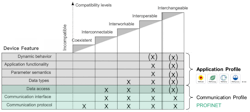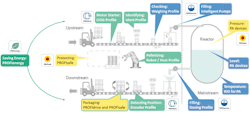A case for vendor-agnostic interoperable industrial devices and networks
A Control Design reader writes: We have some manufacturing customers that are becoming more vendor-agnostic. Occasionally, they are hunting for the best-in-class equipment choice or looking for better value on a specific piece of equipment or software. But by and large, our customers are not open to vendors they’re not familiar with or mixing technologies. As system integrators, we see value in vendor-agnostic products and machines and the growing need for open communication protocol standards. For now, we generally give customers what they want, but some in the company are encouraging us to have a more aggressive plan for steering customers away from locking into one vendor or more often considering the need for open platforms. Should we be encouraging manufacturers to move in this direction, and should that be across the board? What should our plan be for recommending components and vendor choices? We work across many types of industries and integrate many different types of machines. Is this type of vendor-agnostic practice and open communication possible across the board? Are there instances where it’s still better to stick with one vendor for all components or systems? Are open communication platforms adequate in all industries in all cases?
Answers
Application profiles help achieve interoperability
What we're talking about, when we talk about application profiles, is increasing the level of compatibility between devices in a network. Figure 1 defines the various levels of compatibility that can be achieved as more device features are standardized. The Profinet specification provides the first level of compatibility by standardizing the protocol, interfaces and data access. Here, it is possible to achieve co-existence and interconnectability at the communication level.
Application profiles take it a step further by standardizing data types, semantics and functionality. Here, it is possible to achieve not only interoperability but even device interchangeability in certain cases. Each application profile is specified and written by PI North America, just like the Profinet protocol.
Application profiles work by structuring data in a consistent object format for a family of devices. In other words, a family of devices always has its data modeled the same way. For example, Figure 2 shows a generic manufacturing environment with a generic upstream process, a generic reaction and a generic downstream process. For just about every step along the way, there is an application profile; in PI there are roughly two dozen in total.
So, there is one for low-voltage switch gear, one for RFIDs, one for drives, one for process instrumentation and so on. The way it works is this: If a device is written to its application profile, then, independent of vendor and independent of type, parameters like voltage, or position, or RPM always come into an engineering tool the same way for easy integration.
One example of an application profile that makes interoperability possible is Profidrive, because drive configuration can be a challenge with set speeds, slope times or current limits, all different and disorganized from different manufacturers.
Profidrive helps make configuration easier by organizing all those parameters in a consistent fashion in the general station description (GSD) file. This organization starts by grouping drive types into application classes—from simple variable-speed drives to more complex, time-synchronized, multi-axis drives. There are six application classes with Class 1, 3 and 4 being the most common as shown in Figure 3.
Each drive type uses the same basic interface across all application classes. This includes state machine control, diagnostic information and specific drive parameters. Application Class 1 is for applications like pumps and fans. The controller sends a speed setpoint to the drive, and the drive maintains speed control. Application Class 3 is for positioning applications. Here, the controller sends information pertaining to position and speed control to the drive, and the drive performs autonomous, single-axis positioning. Application Class 4 is for multi-axis robot and machine-tool applications. To achieve the desired position, the controller modifies the speed setpoint based on the drive continuously sending its position data. This data exchange is why the clocks need to be synchronized between the drive and the controller.
Profinet is an open communication standard that supports interoperability by standardizing communication at the protocol level and at the application level. This allows users more flexible integration and opens more possibilities when it comes to product selection.
Tom Weingartner, technical marketing director / PI North America
Automation SDOs advance coexistence for all technology standards
The importance of industrial communication interoperability is increasing in automation as the number of device connections, driven by the Industrial Internet of Things (IIoT), continues to grow. Whether it’s the need to quickly and easily move data from the factory floor to the cloud and back for process optimization, to have networks fairly coexist together with time sensitive networking or to be able to easily replace devices if the original product isn’t available, interoperability is key to successfully running an automation facility that will be competitive well into the future.
Standards development organizations (SDOs) in automation were originally created to allow for vendor interoperability and to ensure that end users had alternatives, in case vendors went out of business or stopped supporting a given product line. As time has gone on, a handful of technology standards have emerged as having broad installed bases, strong multivendor support, independent conformance testing and continued updates over time.
The next phase of differentiation for SDOs will be developing the ability to easily coexist and cooperate with other technology standards. This is already taking place today with solutions like the Process Automation Device Information Model (PA-DIM) standard that is being collaboratively developed by FieldComm Group, International Society of Automation (ISA) 100 Wireless Compliance Institute (WCI), the User Association of Automation Technology in Process Industries (NAMUR), ODVA, OPC Foundation, Profibus & Profinet International, VDMA, and ZVEI (German Electro and Digital Industry Association).
Digital transformation, enabled by machine learning and artificial intelligence, promises benefits such as predictive maintenance without having to manually set upper and lower control bounds, automatic control-loop optimization, and systemic overall equipment effectiveness (OEE) improvement. To be able to take advantage of these benefits, data must be able to be transported, easily read with proper context and analyzed by edge, enterprise and cloud systems. Industrial communication networks that support open data models, such as PA-DIM and OPC UA, as well as standardized diagnostics such as NAMUR NE 107, can allow for quicker downtime resolution and faster product replacement and enable organizations to better compare performance across facilities. PA-DIM is a process-automation-industry-focused specification that allows for protocol-agnostic communication of common process automation instrument parameters, including semantic IDs as defined by International Electrotechnical Commission (IEC) 61987, using OPC UA information modelling techniques. OPC UA enables reliable, secure diagnostic communications between industrial control system devices and the cloud, as well as to enable common cloud gateway and device management tasks across a wide variety of industries. NAMUR NE 107 diagnostics are standardized process automation diagnostics, regardless of device manufacturer or control network. The adoption of information models such as PA-DIM and OPC UA along with common diagnostics such as NAMUR NE 107, in existing industrial communication networks, such as EtherNet/IP, will enable end users to easily get the information that they need to optimize their businesses. Utilizing standardized information models and diagnostics is a best practice to take full advantage of the benefits of edge and cloud connectivity and analysis.
Additional industrial communication SDO cooperation can be seen in a new interface standard for the acquisition of energy consumption data in industrial manufacturing that is being developed by ODVA, OPC Foundation, Profibus & Profinet International, and VDMA based on OPC UA. Further collaborations include the Industrial Security Harmonization Group (IESHG) between FieldComm Group, ODVA, OPC Foundation, and Profibus & Profinet International that is working to harmonize cybersecurity strategies and concepts so that end users do not face unnecessary complexity when using security concepts in their automation systems. A single conformance test plan for the Institute of Electrical and Electronics Engineers (IEEE)/IEC 60802 Time Sensitive Networking (TSN) profile for Industrial Automation is also planned by the Avnu Alliance, comprised of the CC-Link Partner Association (CLPA), ODVA, OPC Foundation, and Profibus & Profinet International.
It’s important to note that it’s unlikely that there will ever be one network that will solve every need in industrial automation. Industrial communication networks have varying advantages across different applications and industries. The key is to architect solutions that rely on open standards such as PA-DIM, OPC UA, and NAMUR NE 107 and have a track record of cooperating with other standards development organizations.
Steve Fales, director of marketing / ODVA
Protocol converters are a way out of locked environments
There are some major benefits that come with being more vendor-agnostic, so it comes as no surprise that manufacturers and integrators are embracing this approach with increasing enthusiasm. A vendor-agnostic approach allows for more overall flexibility, more resilience to component shortages, more freedom to choose the right tool or platform for the job and other valuable benefits that are considerably harder to come by when you are locked into a vendor-specific ecosystem. As is often the case in industrial automation, the “why” of vendor agnosticism is relatively clear but the “how” is much less clear—and it’s exactly where users are more likely to make costly mistakes.
Vendor agnosticism is typically achieved with open communication protocols which allow devices produced by a variety of competing vendors to “speak the same language” and communicate directly with each other.
These open communication protocols, which include Modbus, OPC UA, message queuing telemetry transport (MQTT) and others, go a long way toward enabling a vendor-agnostic approach, but individual vendors are still responsible for implementing these protocols, and users are still responsible for making sure all of their devices support a common communication protocol. This is further complicated by the fact that users transitioning to relatively newer protocols such as MQTT are likely to have several legacy devices still in use, which are not directly compatible with the newer protocol.
As an example, consider a manufacturing plant where there are several legacy meters installed, which only support serial communications. The meters still work great, but they cannot communicate directly with some newly installed equipment in the plant, which uses a vendor-specific protocol. In this situation, there are two options: rip and replace all of the legacy panel meters with vendor-specific panel meters or implement an industrial protocol converter to act as a “translator” between the legacy panel meters and the vendor-specific equipment. As one might imagine, implementing a protocol converter will come at a greatly reduced cost, when compared to ripping and replacing multiple legacy devices with vendor-specific devices. Once implemented, the protocol converter will convert the legacy serial communications to the vendor-specific protocol and vice versa, allowing for seamless communications between the previously incompatible devices.
Industry-leading protocol converters include support for more than 300 industrial communications drivers, including both open protocols and vendor-specific protocols, and allow users to convert multiple protocols simultaneously, making them incredibly adaptable to a variety of devices and applications.
These types of advanced protocol converters make it easy to pursue a truly vendor-agnostic approach by allowing users to confidently pick and choose equipment from multiple vendors without worrying nearly as much about compatibility. Instead of being locked into a specific vendor and/or protocol when selecting new equipment, protocol converters allow users to mix and match a wide variety of vendors/protocols as needed and always select the right tool for the job without worrying about sacrificing communications.
A vendor-specific environment can sometimes feel like a “walled garden” or even a “ball and chain,” but protocol converters provide a way out of these locked-in environments, while putting the power of industrial data back in the hands of the users.
Joe Wagner, field application engineer / Red Lion Controls
Say yes to open industrial protocols
Should system integrators be introducing automation users to vendor-agnostic technology by offering best-in-class equipment? In short, absolutely. This allows system integrators to achieve three highly valued results for their end users:
- System integrators build flexibility into their downstream users’ architectures.
- System integrators diversify their access to upstream manufacturers’ development teams.
- System integrators foster a deeper relationship with their users.
COVID-19 has given system integrators a unique opportunity—the opportunity to compare manufacturer performance side by side during a systematic shock. Across the board there have been uptime success stories of end users leveraging their supply chain diversification to increase production uptime through the total number of device level components, which can integrate into the native factory architecture.
The overlying message is flexibility. End users can prepare for the future and ultimately determine their own destinies with the ability to remain nimble to discontinuation, shifting delivery times and emerging new technologies. While easy to declare, the execution is where tangible value is created. Globally open industrial protocols have seen accelerated adoption across industries, geographies and demographics of users since the onset of COVID-19. This adoption is driven by end users’ need to remain flexible without compromising machine performance. Both are fulfilled simultaneously by using globally open industrial protocols as they were designed specifically:
- EtherCAT for high-speed motion
- EtherNET/IP for larger data packets
- IO-Link for granular data harvesting
- OPC UA for pushing aggregated data without middleware.
To paraphrase Douglas MacArthur, no plan ever survives its first encounter with the enemy, and designing with flexibility helps keep end users always in control.
Relying on a single manufacturer as the sole provider of new technology was a strong tactic when the concentration of intellectual property remained cloistered in a single location, such as Bell Laboratories or Menlo Park laboratory. However, the coming wave of generative artificial intelligence, the commonization of critical computing components and ubiquitous access to cloud computing is exponentially accelerating the speed with which all manufactures can scale a single breakthrough to global constituencies across the automation sector. Without a method to integrate new technologies into native architectures quickly and efficiently, end users can be left behind in a hyper-competitive landscape. This becomes especially true as the window to gain a competitive advantage from new technology shrinks.
Shifting focus to globally open industrial protocols allows system integrators to quickly leverage new technologies from across manufacturers and give their users a distinct quantifiable performance compared to their single sourced peers. This is achieved by removing an asymmetric all-or-nothing bet on the premise that a single manufacturer is coincidently focused on solving the exact issue which plagues a specific end user.
Leveraging globally open industrial protocols allows system integrators to tap into a network where each manufacturer brings their own unique value from niche applications for the betterment of all.
Championing globally open industrial protocols as the foundation for an automation architecture can be a mindset shift—a shift away from complete reliance on a sole vendor to a reliance on a network of vendors who conform to a single standard of communication. While taking a globally open industrial protocol perspective on automation communication may introduce new vendor manufacturers to end users, the awareness of the vendor does not always correlate to the infancy of the manufacturing firm itself.
To borrow an illustrative example from Neil DeGrasse Tyson, when opening yourself to new technologies, as your area of knowledge grows, so does the perimeter of the unknown.
This is good news, as it allows integrators to assume the role of the educator and trusted advisor, bridging the relationship gap from purely transactional to a real partnership. Introducing a new product manufacturer to an end user is not inherently bad, especially when that vendor has a proven track record globally and is prepared to support the integration process.
What should the plan be for recommending components and vendor choices? In short, collaborate. Manufacturers who use globally open industrial protocols know all too well that validating interoperability is the first step to instilling confidence in a flexible yet robust machine design. The good news is that system integrators are not alone in this validation process. Manufacturers are investing heavily in proof-of-concept centers, which welcome end users and system integrators alike to collaborate and prove new designs before bringing the design to the plant floor. With uncertainty prevalent across consumer markets, next-generation software resources readily available and the pressure to rapidly adopt new technology, can we afford not to champion globally open industrial protocols?
Thomas Kuckhoff, product manager, core technology / Omron
About the Author
Anna Townshend
Managing Editor
Anna Townshend has been a writer and journalist for 20 years. Previously, she was the editor of Marina Dock Age and International Dredging Review, until she joined Endeavor Business Media in June 2020. She is the managing editor of Control Design and Plant Services.

Leaders relevant to this article:





